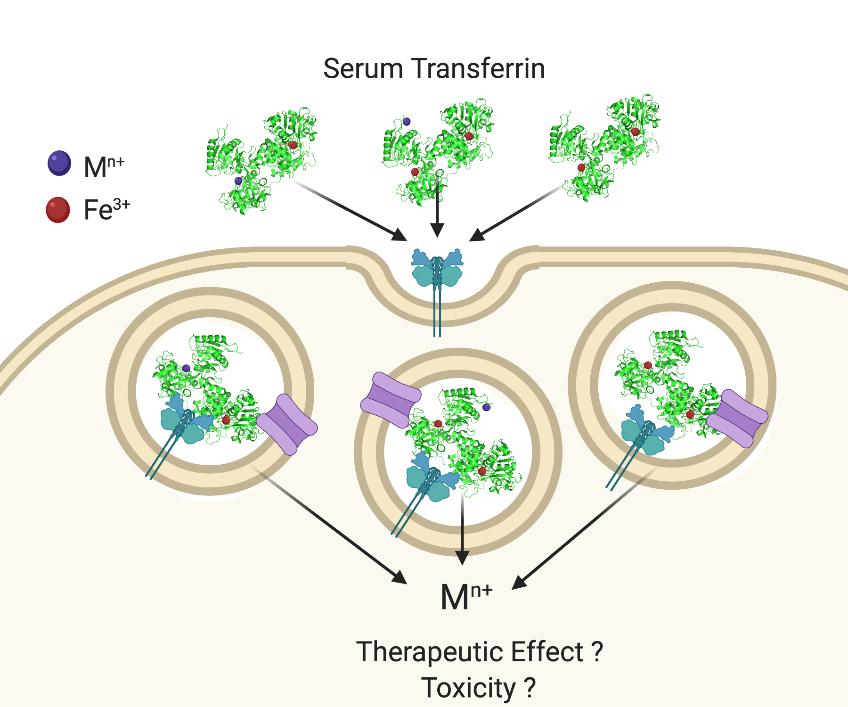What is TF Protein
Transferrin, also known by its official full name "Serotransferrin," is a multifunctional glycoprotein found in human blood and other biological fluids. This protein is an essential component of the iron transport system in the body, serving as a carrier for iron ions. Transferrin is also referred to as beta-1 metal-binding globulin or siderophilin in scientific literature. It belongs to the transferrin protein family and plays a vital role in iron homeostasis.
Recent studies have focused on the role of transferrin in various physiological and pathological processes. Researchers have uncovered new insights into the molecular mechanisms underlying transferrin's functions and have identified potential applications in the field of biomedicine.

Figure 1. Serum Transferrin regulates the therapeutic effects and toxicity of nonferric metals. (Benjamín-Rivera J A, et al., 2020)
TF Protein Structural Characteristics and Classification
Transferrin is primarily synthesized and secreted by the liver, and it circulates in the bloodstream. This glycoprotein is characterized by a bilobal structure, with each lobe capable of binding one ferric (Fe3+) iron ion. Transferrin has a high binding affinity for iron, which helps prevent the accumulation of free iron in the blood, as excess iron can be toxic.
TF Biological Functions and Molecular Mechanisms
Transferrin serves several crucial biological functions in the human body:
- Iron Transport: Its primary role is to transport iron ions in the bloodstream. Transferrin binds to iron in the intestine, where it is absorbed, and carries it to target tissues, such as the bone marrow for erythropoiesis (red blood cell production).
- Iron Homeostasis: Transferrin helps maintain iron balance by regulating the distribution and availability of iron. It ensures that iron is delivered to cells that need it while preventing excess iron from causing oxidative damage.
- Immune Response: Transferrin can also play a role in the immune system by sequestering iron from pathogens. Bacteria and other microorganisms require iron for growth and survival, and transferrin can help restrict their access to this essential nutrient.
- Cellular Growth and Differentiation: Transferrin has been shown to influence cell growth and differentiation by modulating iron delivery to cells. It plays a role in processes like tissue repair and regeneration.
TF Related Signal Pathway
Transferrin signal pathways involve iron uptake and regulation. When transferrin binds to the transferrin receptor on cell surfaces, it triggers a series of events, including endocytosis of the transferrin-iron complex, release of iron in endosomes, and subsequent cellular utilization or storage of iron.
TF Related Diseases
Imbalances in transferrin levels or dysfunction of the protein can lead to various health issues. Some of the transferrin-related diseases include:
- Iron Overload Disorders: Hemochromatosis is a genetic disorder that results in excessive iron absorption and can lead to iron overload in the body. Transferrin saturation tests are often used to diagnose this condition.
- Anemia: Insufficient transferrin or impaired iron transport can lead to anemia, a condition characterized by a reduced number of red blood cells and low hemoglobin levels.
- Infections: Certain pathogens have evolved mechanisms to acquire iron from transferrin, which can contribute to infectious diseases.
- Neurodegenerative Diseases: Some research suggests a potential link between transferrin and neurodegenerative diseases like Alzheimer's disease.
TF's Applications in Biomedical
Transferrin has found applications in various aspects of biomedicine, including diagnostics, vaccine development, and therapeutics.
- Diagnostic Development: Transferrin levels and transferrin saturation are commonly measured in diagnostic tests to assess iron status and disorders like hemochromatosis.
- Vaccine Development: Transferrin can be used as a carrier protein in vaccine development. By attaching antigens to transferrin, researchers aim to enhance the immune response and improve vaccine efficacy.
- Therapeutics: Transferrin-based therapies are being explored for conditions like iron overload disorders and certain types of cancer. Researchers are developing targeted drug delivery systems using transferrin to deliver anticancer drugs specifically to cancer cells, minimizing side effects on healthy tissues.
Recommended Products
| Cat.# | Product name | Species | Source (Host) | Tag |
|---|---|---|---|---|
| TF-3192H | Recombinant Human TF, GST-tagged | Human | E.coli | GST |
| TF-056H | Active Recombinant Human TF protein, His-tagged | Human | HEK293 | His |
| TF-462H | Recombinant Human TF Protein, Animal Free | Human | CHO-K1 | |
| TF-147H | Recombinant Human TF Protein, His-tagged | Human | E.coli | His |
| TF-001H | Active Recombinant Human TF Protein | Human | Oryza Sativa | |
| TF-393HFL | Recombinant Full Length Human TF Protein, C-Flag-tagged | Human | Mammalian cells | Flag |
| TF-651H | Recombinant Human TF Protein, MYC/DDK-tagged | Human | HEK293 | Myc/DDK |
| TF-4777H | Human Transferrin | Human | Human Plasma | N/A |
| TF-4778H | Human Transferrin | Human | Human Plasma | N/A |
| TF-62H | Recombinant Human Apo Transferrin (ATF) | Human | N/A |
Reference
- Benjamín-Rivera J A, et al. Exploring serum transferrin regulation of nonferric metal therapeutic function and toxicity. Inorganics. 2020, 8(9): 48.

